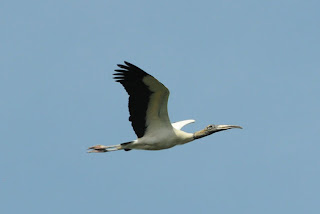The 2nd Annual South Carolina Master Naturalist Conference was held at Palm Key (outside of Ridgeland, SC) during May 13-15, 2010. The Master Naturalist program in South Carolina continues to grow. There are groups in the Upstate, the Lowcountry (Beaufort area), the Winyah Bay area, and the recently-formed Coastal Master Naturalist Association in the Charleston area.
Palm Key is a collection of cottages surrounding a freshwater pond, meeting building and kitchen/dining building. The first evening consisted of an orientation for the conference and social time. We spent most of the time talking about Beidler Forest with those that had visited during one the of Lowcountry Institute Master Naturalist trips or with those that had heard of Beidler Forest from other participants. We always have time to let people know that we exist and why the old-growth swamp is special.
 Beyond networking with like-minded individuals from around the state, we had the opportunity to see natural areas with guides familiar with the local habitats! The first morning, we drove to Bennett’s Point (beyond the Bear Island WMA) in the ACE Basin for a ride on the SC DNR education boat with Al Segars and his staff. We were welcomed by a Eurasian Collared Dove. Once on the boat, we discussed the ACE Basin system and trawled for life in the Ashepoo River, which included shrimp, various flat fish, horseshoe crabs, blue crabs, squid, and a variety of small fish. SC DNR staff on another boat were surveying fish and caught a young Green Sea Turtle, which allowed us a close-up look. On Otter Island, we investigated a fresh Loggerhead Turtle nest, which Al stated would be cleaned out later that evening by the island’s healthy raccoon population. The large Diamondback Rattlesnakes on Otter Island are not able to consume an adult raccoon, so the raccoon population has few checks beyond disease.
Beyond networking with like-minded individuals from around the state, we had the opportunity to see natural areas with guides familiar with the local habitats! The first morning, we drove to Bennett’s Point (beyond the Bear Island WMA) in the ACE Basin for a ride on the SC DNR education boat with Al Segars and his staff. We were welcomed by a Eurasian Collared Dove. Once on the boat, we discussed the ACE Basin system and trawled for life in the Ashepoo River, which included shrimp, various flat fish, horseshoe crabs, blue crabs, squid, and a variety of small fish. SC DNR staff on another boat were surveying fish and caught a young Green Sea Turtle, which allowed us a close-up look. On Otter Island, we investigated a fresh Loggerhead Turtle nest, which Al stated would be cleaned out later that evening by the island’s healthy raccoon population. The large Diamondback Rattlesnakes on Otter Island are not able to consume an adult raccoon, so the raccoon population has few checks beyond disease.Al also reminded everyone that foreign-raised shrimp are produced without the same oversight as in this country. We don’t know what the shrimp are being fed…it would be nice to know as they eat anything. Habitat is also destroyed and contaminated during the creation and operation of the large shrimp farms. The foreign-grown shrimp are sent to this country in refrigerated sea containers and yet that shrimp is cheaper than local shrimp. Foreign-raised shrimp must be produced cheaply in order to be sent around the world and still undercut local prices. Supporting local shrimpers not only keeps the money in the local economy, it helps protect habitat around the world and may well protect you health.
After the boat tour, Chris Marsh took us through the Donnelley WMA where we saw a variety of habitats, including freshwater ponds. There were nesting Wood Storks and Black-bellied Whistling Ducks, which were life birds for most of the participants. Other life birds on the day were Wimbrel, White-rumped Sandpiper, Mottled Duck, and Black-bellied Plover.
The evening’s program included a herps presentation by Tony Mills of the Lowcountry Institute. We will be borrowing several ideas from Tony for use during our summer camp. After the presentation, there was more networking and Beidler Forest app demonstrations around the bonfire.
At the beginning of the second day, we drove to Spring Island for a habitat safari with Tony Mills and Kristen Marshall Mattson. We visited a variety of habitats, including salt marsh, longleaf pine, freshwater impoundments, and mixed hardwood. Again, we will borrow some of the herp-related ideas for our summer camp. Note: teachers don’t steal, they borrow.
The afternoon was spent with Laura Lee Rose, a local Clemson Extension agent, walking in the Altamaha Towne Heritage Preserve. We learned some more about the native plants in our area though we still feel woefully deficient regarding the subject.
The evening’s program included a presentation by Dr. Rob Young who is studying our bottlenose dolphin populations in order to better manage our coastal resources. We learned that there are marsh dolphin populations that seldom, if ever, go out into the ocean and therefore behave slightly differently. There are close-shore populations that migrate slightly north and south along the coast and there are deep-water populations. Strand feeding was shown and described. A graduate students will be marking with paint some of the birds that follow the dolphins to see if it is a small set of birds making a living off of the dolphins’ behavior or if it is a larger set of birds that come and go. If it is a smaller set, why haven’t more birds picked up on this easy way of life?
We won the photo contest with the image showing three Gulf Fritillaries during the Mepkin Abbey field trip. We'll see everyone next year!
Images by Mark Musselman






No comments:
Post a Comment